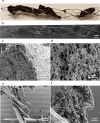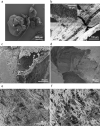A high resolution scanning electron microscopy analysis of intracranial thrombi embedded along the stent retrievers
- PMID: 35577906
- PMCID: PMC9110407
- DOI: 10.1038/s41598-022-11830-4
A high resolution scanning electron microscopy analysis of intracranial thrombi embedded along the stent retrievers
Abstract
Endovascular treatment with stent retriever thrombectomy is a major advancement in the standard of care in acute ischemic stroke (AIS). The modalities through which thrombi embed along stent retriever following mechanical thrombectomy (MTB) have not yet been elucidated. Using scanning electron microscopy (SEM), we analyzed the appearance of thrombi retrieved by MTB from AIS patients, when embedded into the stent retriever. We observed that the organization and structural compactness vary for compositionally different thrombi. The modalities of attachment onto the stent vary according to thrombus composition and organization.
© 2022. The Author(s).
Conflict of interest statement
The authors declare no competing interests.
Figures






Similar articles
-
High-Resolution Imaging of Interaction Between Thrombus and Stent-Retriever in Patients With Acute Ischemic Stroke.J Am Heart Assoc. 2018 Jun 22;7(13):e008563. doi: 10.1161/JAHA.118.008563. J Am Heart Assoc. 2018. PMID: 29934420 Free PMC article.
-
Adjustment of Stent Retriever Length to Clot Extent Affects First-Pass Reperfusion in Endovascular Treatment of Acute Ischemic Stroke.Cerebrovasc Dis. 2020;49(3):277-284. doi: 10.1159/000508028. Epub 2020 Jun 16. Cerebrovasc Dis. 2020. PMID: 32544906
-
The use of stent retrievers in acute ischemic stroke.Expert Rev Neurother. 2016 Aug;16(8):969-81. doi: 10.1080/14737175.2016.1193007. Epub 2016 Jun 7. Expert Rev Neurother. 2016. PMID: 27219051 Review.
-
Acute ischemic stroke thrombi have an outer shell that impairs fibrinolysis.Neurology. 2019 Oct 29;93(18):e1686-e1698. doi: 10.1212/WNL.0000000000008395. Epub 2019 Sep 20. Neurology. 2019. PMID: 31541014 Free PMC article.
-
Safety and Efficacy of Stent Retrievers for the Management of Acute Ischemic Stroke: Comprehensive Review and Meta-Analysis.JACC Cardiovasc Interv. 2015 Nov;8(13):1758-65. doi: 10.1016/j.jcin.2015.07.021. JACC Cardiovasc Interv. 2015. PMID: 26476611 Review.
Cited by
-
The Stream Device-A Retrospective Review of 51 Cases.J Clin Med. 2023 Oct 6;12(19):6384. doi: 10.3390/jcm12196384. J Clin Med. 2023. PMID: 37835028 Free PMC article.
-
Shell Versus Core Architecture and Biology of Thrombi in Acute Ischemic Stroke: A Systematic Review.Clin Appl Thromb Hemost. 2023 Jan-Dec;29:10760296231213632. doi: 10.1177/10760296231213632. Clin Appl Thromb Hemost. 2023. PMID: 37960892 Free PMC article.
-
Thrombus composition in ischaemic stroke: histological and radiological evaluation, and implications for acute clinical management.J Thromb Thrombolysis. 2025 Mar;58(3):355-369. doi: 10.1007/s11239-025-03074-6. Epub 2025 Mar 21. J Thromb Thrombolysis. 2025. PMID: 40117100 Free PMC article. Review.
-
The NeVa stent-retriever - a single-centre real-world experience.Interv Neuroradiol. 2025 May 21:15910199251337176. doi: 10.1177/15910199251337176. Online ahead of print. Interv Neuroradiol. 2025. PMID: 40398472 Free PMC article.
-
A hyper-viscoelastic uniaxial characterization of collagenous embolus analogs in acute ischemic stroke.J Mech Behav Biomed Mater. 2024 Nov;159:106690. doi: 10.1016/j.jmbbm.2024.106690. Epub 2024 Aug 24. J Mech Behav Biomed Mater. 2024. PMID: 39205348
References
Publication types
MeSH terms
Grants and funding
LinkOut - more resources
Full Text Sources
Medical

